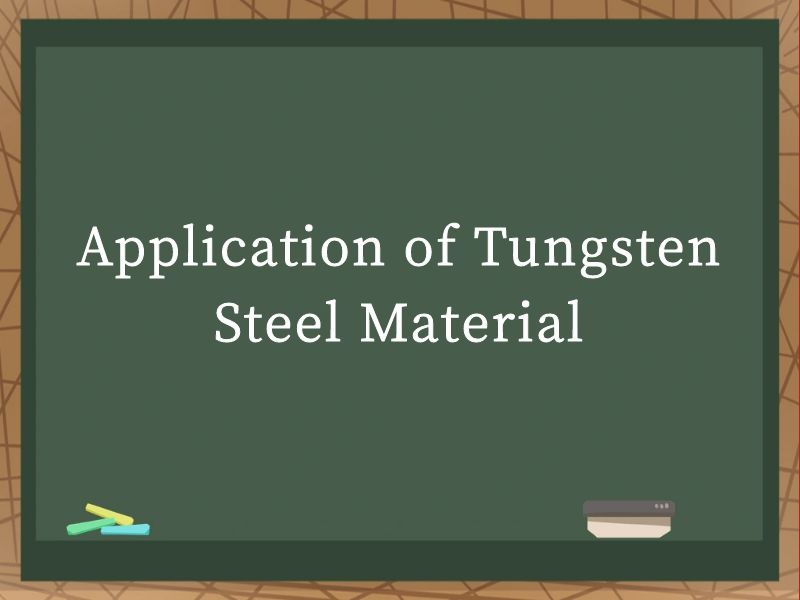JOURNALISM
- NEWS -
|
Application of Tungsten Steel MaterialApplication of Tungsten Steel Material.Tungsten steel, also known as high-speed steel, is a versatile alloy renowned for its exceptional hardness, wear resistance, and heat resistance. This material has found extensive applications across various industries due to its unique combination of mechanical and thermal properties. This article delves into the characteristics, manufacturing processes, and diverse applications of tungsten steel material, highlighting its significance in modern industrial settings.
Characteristics of Tungsten Steel Tungsten steel is primarily composed of tungsten, carbon, chromium, vanadium, molybdenum, and cobalt. Tungsten, being one of the densest elements on Earth, contributes significantly to the alloy's hardness and wear resistance. Chromium and molybdenum enhance corrosion resistance, while vanadium and cobalt improve toughness and red-hardness (the ability to maintain hardness at high temperatures). Hardness and Wear Resistance One of the most notable characteristics of tungsten steel is its extreme hardness. This property makes it ideal for applications where high levels of abrasion and wear are expected. The hardness of tungsten steel can be further increased through heat treatment processes, such as quenching and tempering, which optimize its microstructure for maximum durability. Heat Resistance Tungsten steel maintains its hardness and strength even at elevated temperatures, a feature crucial for applications involving high-temperature environments. The alloy's red-hardness ensures that it retains its cutting edge and mechanical properties during operations like machining and drilling, where friction-generated heat can reach several hundred degrees Celsius. Toughness and Flexibility Despite its hardness, tungsten steel also exhibits a remarkable balance of toughness and flexibility. This dual characteristic allows it to withstand impact loads without fracturing, making it suitable for applications that require both high hardness and shock resistance. Manufacturing Processes of Tungsten Steel The production of tungsten steel involves several complex steps, from raw material preparation to final heat treatment. Each stage is critical to achieving the desired material properties. Alloying and Casting The manufacturing process begins with the careful selection and blending of raw materials. These include tungsten carbide powder, cobalt, chromium, molybdenum, and vanadium alloys. The mixed powders are then pressed into ingots or billets, which are subsequently melted and cast into the desired shapes. Forging and Rolling After casting, the ingots undergo hot forging and rolling processes to shape them into bars, rods, sheets, or other forms. These operations improve the material's internal structure, enhancing its mechanical properties and reducing porosity. Heat Treatment Heat treatment is a crucial step in the manufacturing of tungsten steel. It involves quenching the material at high temperatures followed by rapid cooling to lock in the desired microstructure. Tempering at lower temperatures reduces internal stresses and improves toughness, ensuring a balance between hardness and ductility. Machining and Finishing Finally, the tungsten steel components are machined to precise dimensions and finished to meet specific application requirements. This may involve grinding, polishing, or other surface treatments to achieve the desired surface roughness and dimensional accuracy. Applications of Tungsten Steel Material Tungsten steel's unique properties make it indispensable in numerous industries, from cutting tools to aerospace components. Below are some key application areas: Cutting and Machining Tools Tungsten steel is the backbone of the metalworking industry, particularly in the manufacture of cutting tools such as drills, taps, end mills, and reamers. Its hardness and heat resistance enable these tools to maintain sharp edges and withstand the intense friction and heat generated during machining operations. This leads to longer tool life, improved surface finish, and increased productivity. In addition to traditional machining, tungsten steel is also used in advanced manufacturing processes like waterjet cutting and laser cutting, where its ability to withstand high-energy beams and abrasive media is crucial. Mining and Construction Equipment The mining and construction sectors rely heavily on tungsten steel for the manufacture of drill bits, excavator teeth, and other wear parts. These components are exposed to extreme abrasion and impact, making tungsten steel's hardness and toughness essential for maintaining equipment performance and reducing downtime. Aerospace and Defense In the aerospace and defense industries, tungsten steel is used in the manufacture of high-performance components such as turbine blades, rocket nozzles, and armor piercing rounds. Its heat resistance and high-density make it ideal for applications involving high temperatures and extreme forces. Medical and Dental Instruments Tungsten steel's corrosion resistance and biocompatibility make it an excellent choice for medical and dental instruments. Surgical blades, drills, and other cutting tools benefit from tungsten steel's hardness and edge retention, ensuring precision and reliability during medical procedures. Automotive Industry The automotive industry leverages tungsten steel in the production of high-performance components such as engine valves, gearbox components, and brake systems. Its ability to withstand high temperatures and pressures, combined with excellent wear resistance, contributes to improved vehicle efficiency, durability, and safety. Electronics and Semiconductor Manufacturing In the electronics and semiconductor industry, tungsten steel is used in the fabrication of precision tools for wafer dicing, die bonding, and other micro-machining processes. Its high hardness and precision machinability ensure accurate and reliable manufacturing of delicate electronic components. Future Trends and Developments As technology advances, the demand for tungsten steel with enhanced properties continues to grow. Researchers are exploring new alloy compositions and manufacturing techniques to further improve the material's hardness, wear resistance, and heat tolerance. Nanotechnology and Coatings One promising area of research involves the application of nanotechnology to enhance tungsten steel's properties. Nanostructured coatings, for instance, can significantly improve the material's surface hardness, corrosion resistance, and tribological performance. Composite Materials The development of tungsten steel-based composites, combining the alloy with other materials like ceramics or polymers, offers the potential for even higher performance. These composites can exhibit enhanced mechanical properties, thermal stability, and wear resistance, making them suitable for extreme applications. Sustainable Manufacturing The push for sustainable manufacturing practices is also driving innovations in tungsten steel production. Efforts are being made to reduce waste, improve energy efficiency, and recycle materials to minimize the environmental impact of tungsten steel manufacturing. Tungsten steel's exceptional combination of hardness, wear resistance, and heat resistance has cemented its role as a critical material in numerous industries. From cutting tools to aerospace components, its versatility and durability make it an indispensable part of modern industrial settings. As research continues to push the boundaries of material science, the future of tungsten steel looks even more promising, with new applications and enhanced properties on the horizon. In summary, tungsten steel is a material of choice for applications requiring high hardness, wear resistance, and heat tolerance. Its manufacturing processes, from alloying and casting to heat treatment and machining, are meticulously controlled to ensure optimal material properties. As industries evolve and technology advances, tungsten steel will continue to play a pivotal role in driving innovation and efficiency in various sectors. |


